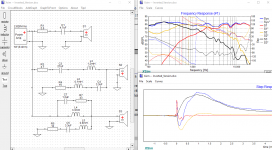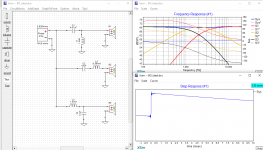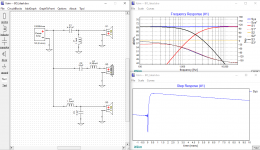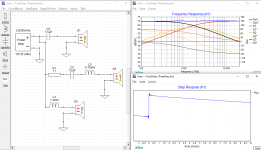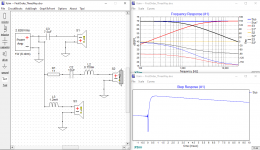The more you want from God, the more he's like a devil.
This is probably the last example. I here use a three way design but using first order. It's a non-coherent design with the mid being inverted polarity, while the woofer and tweeter are positive polarity. So I guess you would expect that being a first order design, the step response should not be complicated right?
But I guess as anything in life, as you want more and more, things start get complicated. The step response now looks a bit of a mess. Interestingly, the step response looks a bit like a 2way using 3rd order filters. I don't know if it's a coincidence or not, a 2way using second order looks the same as a 2way using first order filter. Looks like anything 3 or above is where HE's starting to get real pissed.
Anyway, I'll leave it to the consideration of the readers (if there's any lols).
Attachments
Last edited:
“So where does that leave us?” from “The Lovers”.
After looking at various step response of various designs – coherent and “transient perfect”, first order non-coherent, third order, 2way, 3way and so on … you can see the elegance of the coherent design with a proper step response. The non-coherent design step response does make me feel a bit uneasy.
On the one hand, there are a lot of speakers that are designed that use high order filters (infinite slope … for example) that sound just fine.
But on the other hand, we also know phase shifts do affect the sound quality such as MP3, early 1980's digital music.
I also talk to a lot of people who have said that they “do” hear difference in first order filter speaker vs. higher order speaker, me included. The consensus is that in high order filter speaker, the most difference comes from the treble. In first order design, the treble is more integrated with the music, whereas in high order filter, the treble seems more like it's riding on top of the music.
So should we ask which is better? Maybe we should leave it at it between the listener and his lover ….. errrrr ….. I meant his speakers lols.
More to come ...
It's a complete waste of time and effort. It doesn't not lead to a better speaker.
Tuning was successful if performance did not drop more than 15 %.
I also talk to a lot of people who have said that they “do” hear difference in first order filter speaker vs. higher order speaker, me included. The consensus is that in high order filter speaker, the most difference comes from the treble. In first order design, the treble is more integrated with the music, whereas in high order filter, the treble seems more like it's riding on top of the music.
So should we ask which is better? Maybe we should leave it at it between the listener and his lover ….. errrrr ….. I meant his speakers lols.
More to come ...
Again, if you take two or 3 drivers and build a speaker with passive crossover, it will sound different with different crossovers, regardless of whether they are TP or not, because when you change the crossover order and type you change more than just the axial frequency response (amplitude and phase). You change the polar response, driver overlap, driver excursion, distortion, etc., and that leads to different sounding speakers even if the axial amplitude response is identical.
This thread is a perfect example. Here Andy2 has designed numerous different TP system that all produce relatively similar step responses. Do they all now sound the same because they are TP? Of course not.
Another thing to consider with a multiway system is that it is the sum of the output of all the drivers that yields the TP response. Each individual driver is introducing a phase shift in its band pass that cancels the phase shift introduced by another drivers. Using the B&O concept as an example, if you keep Fc of the HP and LP 2nd order response the same fc(hp) = fc(LP) and design systems where the Q of these filters are different (there is no requirement that Q = 0.5, nor is there a requirement that Q(LP) = Q(HP) ), they will all be TP. But how the drivers sum will be different resulting is different polar response because the phase of each driver will have a different frequency dependence. This difference in phase leads to other factors as well. Consider the sum of the woofer + filler. This sum must then sum to the tweeter to yield zero phase. With one selection of Q the woofer + filler sum may have an amplitude of 0.707 @ 45 degrees at a given frequency which will sum to the tweeter which has an output of amplitude 0.707 @ -45 degrees at the same frequency. The sum is amplitude 1@ 0 degrees. A different selection of Q may yield the woofer + filler output = 1@ 60 degrees while the tweeter output is 1 @ -60 degrees. Again, the sum is 1 @ 0 degrees. So the same result is achieved but the individual drivers are behaving very differently, reproducing their component with different amplitude and phase.
The point, again, is that just because you have achieved a TP response on axis doesn't mean that differences in what you hear, compared to a system built with the same drivers but not TP, can be attributed to the TP nature of one of the systems, better or worse.
I admire Andy2 for the effort he is making. Having been through it I know the effort. But having done it, other than for the exercise, it's a complete waste of time and money to pursue this approach for a quality speaker.
John – Glad to see you’re still active here in your retirement. A few years back I discovered the work you did on TP and quasi-TP passive crossovers in the early 2000’s. At that time your “It’s Just a Phase I Am Going Through” paper was my design inspiration. So it was it was very interesting to see your response when it finally became possible to do an apples-to-apples comparison of linear phase vs non-linear phase crossovers using tools like Ultimate Equalizer. After all that work it must have been difficult to conclude that linear phase crossovers aren’t the magic bullet that many make them to be.
John – Glad to see you’re still active here in your retirement. A few years back I discovered the work you did on TP and quasi-TP passive crossovers in the early 2000’s. At that time your “It’s Just a Phase I Am Going Through” paper was my design inspiration. So it was it was very interesting to see your response when it finally became possible to do an apples-to-apples comparison of linear phase vs non-linear phase crossovers using tools like Ultimate Equalizer. After all that work it must have been difficult to conclude that linear phase crossovers aren’t the magic bullet that many make them to be.
Hey guys, I read this and have to ask again....
were your (John K) listening tests phase linearization on top of crossovers already in place..what I call global FIR on inputs..
or were they drivers individually flattened with minimum phase EQ and then put together with linear phase crossovers.. ????
There is a world of difference....the first method just doesn't add anything ime, whereas the second rocks, again ime......that's why i ask...
I put together a 3way xover using ideal drivers so it's a little better to see how the phase of the woofer, mid, and tweeter matched up in a "B&O" filter setup. Of course, the woofer and the tweeter are using 2nd order filters. The mid is using first order filter.
1. The first one is with all the drivers on. Overall system phase is 0 degree phase shift. The system shows proper step response.
2. The second one is with the mid off. The tweeter is inverted to show that without the mid, the system is basically a 2way system using 2nd order filter roll off. So the phase shift is -180 degree at 20KHz.
1. The first one is with all the drivers on. Overall system phase is 0 degree phase shift. The system shows proper step response.
2. The second one is with the mid off. The tweeter is inverted to show that without the mid, the system is basically a 2way system using 2nd order filter roll off. So the phase shift is -180 degree at 20KHz.
Attachments
And in contrast to the "B&O" type filter, the first order filter version does show some very similarities. The only difference is the woofer and tweeter are using 1st order roll off.
1. Again with all drivers all, 0 phase shift. Proper step response.
2. With the mid off, the tweeter inverted polarity, then you have a typical 2way system with the phase shift also at -180 degree at 20KHz.
1. Again with all drivers all, 0 phase shift. Proper step response.
2. With the mid off, the tweeter inverted polarity, then you have a typical 2way system with the phase shift also at -180 degree at 20KHz.
Attachments
If I understood him correctly he was using FIR correction before the crossover. This way he could switch back and forth between transient-perfect and "normal". This way no other properties of the system were changed for the listening test.
When I find the time I will do something different: I willl use a transient-perfcet crossover and switch an allpass in and out before the crossover in order to hear whether it makes any difference. The test will be purely subjective of course but the decision whether I like a topology or not is also a purely subjective one.
Regards
Charles
When I find the time I will do something different: I willl use a transient-perfcet crossover and switch an allpass in and out before the crossover in order to hear whether it makes any difference. The test will be purely subjective of course but the decision whether I like a topology or not is also a purely subjective one.
Regards
Charles
There is a world of difference....the first method just doesn't add anything ime, whereas the second rocks, again ime...
Difference in phase linearisation between input and output FIR depends on band-width of each way. We need to assume phase match between LP and HP slopes when FIR is in the input. For example 2-way would be equal no matter where FIR locates because phase response of individual drivers is equal to phase response of total. 5-way would be more or less different because phase linearisation in input affects to phase response of all individual ways.
Here is 3-way with IIR LR4 crossover at 250 and 2500 Hz. Phase graph shows individual phase responses of all three drivers.
Original IIR crossover with few all-pass filters for phase matching:
An externally hosted image should be here but it was not working when we last tested it.
Phase linearisation with input FIR:
An externally hosted image should be here but it was not working when we last tested it.
Minor non-linearity of W and T is visible at 700-800 Hz. Phase responses of individual drivers is shown above -40 dB filter gain so bigger non-linearity at very low gain/SPL is not visible. But overall impression is that FIR could be in input channel also in this case without significant difference to output implementation in theory.
Practice could be more difficult due to possible limits in dsp gear/app and imperfections of drivers etc.
John – Glad to see you’re still active here in your retirement. A few years back I discovered the work you did on TP and quasi-TP passive crossovers in the early 2000’s. At that time your “It’s Just a Phase I Am Going Through” paper was my design inspiration. So it was it was very interesting to see your response when it finally became possible to do an apples-to-apples comparison of linear phase vs non-linear phase crossovers using tools like Ultimate Equalizer. After all that work it must have been difficult to conclude that linear phase crossovers aren’t the magic bullet that many make them to be.
You bet. 🙂
John, can you list your 3 top parameters, and targets for those, for what you believe is the main drivers to produce a good speaker? Phase seem not to make the list... 🙂
//
//
Hey guys, I read this and have to ask again....
were your (John K) listening tests phase linearization on top of crossovers already in place..what I call global FIR on inputs..
or were they drivers individually flattened with minimum phase EQ and then put together with linear phase crossovers.. ????
There is a world of difference....the first method just doesn't add anything ime, whereas the second rocks, again ime......that's why i ask...
Oh well, I had typed up a detailed response but when I click Submit it didn't work and it was lost. So I'll just say I tried just about every approach I could think of; passive and active speaker systems with phase correction by pre processing (LS3/5a and my NaO system); 2-way, FIR LR4 systems from scratch where each individual driver's acoustic output was switchable between linear phase or minimum phase; LR4 IIR with FIR correction to the system or individual drivers; individual LR2 FIR switchable between minimum phase and linear phase (tweeter revered polarity for min phase normal polarity for Lin phase); ....
The bottom line was that there were times, with certain passages, where sometimes it was though there was a difference, but there was never any consensus on which system was which or which sounded better. It was all pretty random. The only times they was some consistency was with bass response. There was some agreement that bass hade better impact when low frequency phase was linearized. But that is not crossover related.
I will say that for a given passage of music there might be a preference for one over the other due to some subtle difference. But for another piece the preference might be reversed. And when it comes down to comparing a 3-way using a B&O type crossover compared to the same 3-way with LR4 crossovers, as I have tried to point out, there are far bigger differences than just phase response. In fact, in previous posts I linked to my old B&O like TP 3-way, original with passive crossover, then revised with digital crossover. Today that system sounds better than it ever did, since I redesigned it with straight LR4 crossover. It doesn't reproduce a square wave for crap anymore, but it sounds good with music. 🙂
I don't fault anyone who wants to play around with this. And if they feel differently then me, if they believe TP make a difference, God bless. My experience is just different.
One other thing I would like to point out about the B&O approach. I said it before, it is just a subtractive type TP crossover. You set up a LP and an HP and sum them in phase, subtract from flat, zero phase and you get a filler. With 2nd order HP and LP the filler is a 2nd order band pass. But consider the LP and the filler sum. That is what will sum to the HP response to yield flat amplitude and zero phase. So instead of doing it that way, just set up a HP filter and subtract and you get the same response in a single LP as the B&O LP + filler. You will find that response looks like a 2nd order LP with Q>1. Not actually but it has similar appearance, a rise above flat before rolling off. That rise is over 1dB if the HP is an LR2, if a B2 the rise is about 2dB. This means that off axis can have a polar response at certain frequencies where the output is 1 or 2 dB greater than the axial response. With the B&O its' worse because you have two crossover points where the polar get mess up as opposed to one if you use a single LP.
If you look at this old page of mine you can see what the off axis vertical response looks like for the B&O approach when different Qs are chosen.
TP3-project3
Anyway, it's all for fun, isn't it. 🙂
John, can you list your 3 top parameters, and targets for those, for what you believe is the main drivers to produce a good speaker? Phase seem not to make the list... 🙂
//
Not sure I understand your question but above all it has to sound right. For that I want flat axial response, smooth off axis response over as wide an angle as possible (typically there will be high frequency roll off), and a vertical polar response that doesn't peak (above axial) (Linkwitz or Duelund type crossovers).
My ear prefers a little dip (like a BBC dip) in the treble, but I targeted flat in my designs and encouraged anyone who builds my speakers to make adjustments to their ear.
Fortunately, I don't have to worry about it any more.
It was that that point I stopped worrying about linear phase crossovers and TP systems. Yes, they produce nice measurements, but audible differences between an LR4 crossover and the same speaker corrected to linear phase just didn't materialize.
I share your experience. It is nice to be able to reproduce square waves with loudspeakers, but in reality this only is possible at 1 specific point in space in multiway systems. At least, this was what I found in numerous experiments.
But the bottem line is audibility, where I have become convinced that it might be a minute issue, but certainly not much more than that. My focus now is on getting the digital chain all the way to beyond the DSP crossover, using AK4490's for each driver. In my present setup with lesser quality DAC's, I can apply FIR filters to straighten out phase. But I can't really be bothered because for me, that does not improve sound.
I love comments like this from the old hands (in the business), Linkwitz (RIP), Geddes.........you 🙂Fortunately, I don't have to worry about it any more.
@Mark100, if I understand you those two should be the same thing, yes?
Hi AllenB,
I guess I'm really saying, ...theoretically they could be the same...
if we had perfect drivers or the drivers were made near perfect with minimum phase EQ before xover,
and if we had perfect phase overlap between drivers after adding minimum phase xovers.
Then I think phase linearization applied globally on input would closely match driver-by-driver on output with linear phase crossovers.
But perfect drivers and perfect phase alignment are most often miles from reality, huh?
John K's post #84 does a good job of describing some of the real world issues i think, particularity with regard to on-axis vs power distribution.
So I think from a reality viewpoint, FIR correction on [drivers A + B + C summed with minimum phase xovers] does not equal FIR correction on[A] + FIR on + FIR on[C] summed with linear phase crossovers.
Difference in phase linearisation between input and output FIR depends on band-width of each way. We need to assume phase match between LP and HP slopes when FIR is in the input. For example 2-way would be equal no matter where FIR locates because phase response of individual drivers is equal to phase response of total. 5-way would be more or less different because phase linearisation in input affects to phase response of all individual ways.
But overall impression is that FIR could be in input channel also in this case without significant difference to output implementation in theory.
Practice could be more difficult due to possible limits in dsp gear/app and imperfections of drivers etc.
Hi Kimmosto, thanks for example. I've made similar experiments where I run adual channel transfer, of electrical linear phase crossovers vs same order minimum phase xovers linearized with rePhase or other FIR generators.
I get the same thing as you show...electrical equivalence is pretty easy.
When I bring real driver measurements into the picture, I find the degree of work I did driver-by-driver flattening mag and phase with minimum phase EQ, makes a big difference on reassessing crossover equivalence.
- Home
- Loudspeakers
- Multi-Way
- An exercise in converting a speaker to time-phase coherent
